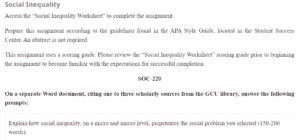Social Inequality
Explain how social inequality, on a micro and macro level, perpetuates the social problem you selected
Social inequality is a big societal problem in the world today. It commonly occurs when there is an unequal distribution of resources in society. As a result, it has led to several social problems, such as poverty, racial discrimination, and unemployment. There are different ways in which social inequality promotes poverty in society. It undermines human rights and social justice, giving some groups of individuals better opportunities than others. Some groups are undermined based on their religion, ethnicity, gender, region, disability status, and race. This has led to poor sections of the world’s population, including many rural populations, persons with disabilities, and older persons leading to poor standards of living. The poor frequently face negative social stereotypes, stigma, and discrimination that decrease their opportunities for employment and social participation (Beker, 2018). Reduced employment opportunities make the poor continue being poorer as the rich become richer. Therefore, inequalities have widened the gap between the rich and the poor.
Explain how social inequality is influenced by individual and institutional discrimination.
There are different ways in which individual and institutional discrimination promote social inequality. For instance, individual discrimination that is based on one’s race prevents some groups of people from having access to certain opportunities. In the United States, several cases have been reported in which Black American students are racially discriminated against by students from other races. This kind of individual discrimination prevents black students from socially interacting with other students. In case black students are racially discriminated against in learning activities, this denies them an opportunity to access certain learning opportunities. Also, there are several cases of institutional discrimination against women in organizations through their policies on human resources. Some organizations have HR practices that undermine women based on the way they pay, train, hire, and motivate their employees (Stamarski et al., 2015). This kind of workplace discrimination, in turn, affects the involvement of women in leadership and women’s earnings, and it minimizes the opportunities available for women to advance in their careers. As a result, women end up having a low socioeconomic status.
Use the GCU library and identify an actual solution to the problem of social inequality. Summarize the solution you identified and compare it to historical solutions proposed in the past
One effective solution to the societal problem of social inequality is through participatory decision-making. Everyone in society should be allowed to participate in the decision-making process. Through participatory decision-making, the groups that are disadvantaged in society can have their voices heard. This can prevent social inequality since some policies undermine some groups of people when they are not meant to undermine them. Allowing everyone to participate in decision-making would lead to the modulation or removal of such discriminatory policies.
Historically, the solutions to social inequality involved promotive action and better targeting of social programs. Advocacy efforts and media campaigns were used to fight different social inequalities, such as racial discrimination (Berezhnaia & Korkonosenko, 2015). The impact of ancient discrimination towards certain groups was thus reduced through affirmative action. Better targeting of social programs was also done through means such as geographical targeting. These programs were aimed at reducing income inequality. The historical solutions are different from my solution since the historical solutions did not consider the causes of the inequalities. My solution considers the causes of inequalities, such as certain policies, and including everyone in decision-making processes can solve the problem of social inequality.
References
Beker, V. (2018). Growth, Inequality, and Poverty : What Do We Know ? SSRN Electronic Journal, March. https://doi.org/10.2139/ssrn.2727231
Berezhnaia, M. A., & Korkonosenko, S. G. (2015). Social Inequalities : Media Approaches and Society Expectations. International Review of Management and Marketing, 5, 62–66.
Stamarski, C. S., Hing, L. S. S., & Elacqua, T. C. (2015). Gender inequalities in the workplace : the effects of organizational structures, processes, practices, and decision makers’ sexism. Frontiers in Psychology, 6(September), 1–20. https://doi.org/10.3389/fpsyg.2015.01400
ORDER A PLAGIARISM-FREE PAPER HERE
We’ll write everything from scratch
Question 
Social Inequality
Access the “Social Inequality Worksheet” to complete the assignment.
Prepare this assignment according to the guidelines found in the APA Style Guide, located in the Student Success Center. An abstract is not required.

Social Inequality
This assignment uses a scoring guide. Please review the “Social Inequality Worksheet” scoring guide prior to beginning the assignment to become familiar with the expectations for successful completion.
SOC-220
On a separate Word document, citing one to three scholarly sources from the GCU library, answer the following prompts:
| Explain how social inequality, on a micro and macro level, perpetuates the social problem you selected (150-200 words).
|
| Explain how social inequality is influenced by individual and institutional discrimination (150-200 words).
|
| Use the GCU library and identify an actual solution to the problem of social inequality. Summarize the solution you identified and compare it to historical solutions proposed in the past (150-200 words).
|
